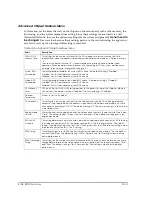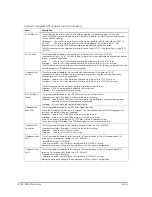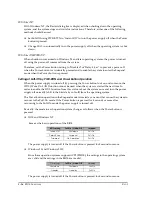
Rev. I
BIOS Functions
5-9
MR series Technical Reference Manual
Security Option
Sets the password entry timing. The default setting is “Setup”. The password is set in Main Menu:
Set Supervisor Password and Main Menu: Set User Password.If a password is not set in these
items, this setting will have no significance.
The relationships between this setting and the password set are as follows:
“Setup” Setting “System” Setting
When starting the OS: --- User Password or Supervisor Password
When changing BIOS Setup: Supervisor Password Supervisor Password
When only displaying BIOS Setup: User Password User Password
OS Select For
DRAM > 64MB
This setting is used to specify whether the OS/2 has more than 64MB of memory or not. The
default setting is “Non-OS2”.
Non-OS2:This setting is used when an OS other than an OS2 is used. This is the normal setting.
OS2:
This setting is used when the OS is an OS2. By using this setting, the method for
communicating the mounted memory capacity changes to a method specified by
the OS2.
HDD S.M.A.R.T
capability
This setting is used to specify whether the S.M.A.R.T (Self-Monitoring, Analysis and Reporting
Technology) function is being used or not. If the connection device is not compatible with ATA-
3 (Ultra-ATA) standards or above, this means that the device does not support the S.M.A.R.T.
function, making this setting invalid. The default setting is "Enabled".
Enabled:"Enabled" is used to set the S.M.A.R.T. function. Please note that in order to use this
setting a command device is necessary to initiate this function during startup and a
separate software package is needed to activate the S.M.A.R.T. function. This is the
normal setting.
Disabled:This setting is used to disable the S.M.A.R.T function.
Report No FDD
For WIN95
This setting is used to communicate to the Microsoft Windows OS whether an FDD is installed or
not (more exactly, the IRQ-6 status) The default setting is "No".
No:
"No" is the setting used when no communication is made to the OS. This is the normal
setting.
Yes:
This setting is used when an FDD is not installed or when the necessary software has not
been installed. More exactly, this setting is used to communicate to the OS that the
IRQ-6 used by the FDC has been opened. Please refer to the section on floppy disks
regarding the use of FDD.
C8000-CBFFF
Shadow
This setting is used to specify whether shadowing is performed or not for each address space
when a PC card with an expanded ROM BIOS is attached to the slot. All default settings are set
to "Disabled".
Disabled:This setting is used when shadowing of the target address spaces is not performed.
More exactly, if no PC card is attached to the slot, then it means that the PC card
does not have an expanded ROM BIOS mounted on it.
Enabled:This setting is used when shadowing of the target address spaces is performed. More
exactly, it means that the PC card attached to the slot has an expanded ROM BIOS,
such as an SCIS network card, mounted on it.
CC000-CFFFF
Shadow
D0000-D3FFF
Shadow
D4000-D7FFF
Shadow
D8000-DBFFF
Shadow
DC000-DFFFF
Shadow
Small Logo
(EPA) Show
This setting is used to enable/disable display of an energy star logo at the top right of the POST
screen. The default setting is set as "Disabled".
Disabled:The "Disabled" setting disables the display.
Enabled:The "Enabled" setting enables the display.
Table A-3 Advanced BIOS Features menu (continued)
Items
Description
Содержание DM-M820
Страница 1: ...Technical Reference Manual MR Series English 403308709 Rev I EPSON ...
Страница 2: ......
Страница 20: ...xviii Rev I ...
Страница 42: ...2 8 Setup for the IM 800 and the DM M820 Rev I ...
Страница 50: ...3 8 Hardware Specifications Rev I ...
Страница 178: ...5 38 BIOS Functions Rev I ...
Страница 216: ...8 26 Troubleshooting Rev I ...
Страница 270: ...9 54 Disassembly and Assembly Rev I 6 Remove the HDD cable 216 from the Main circuit board HDD cable ...
Страница 323: ......
Страница 324: ...SEIKO EPSON CORPORATION EPSON ...







































